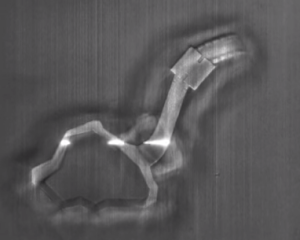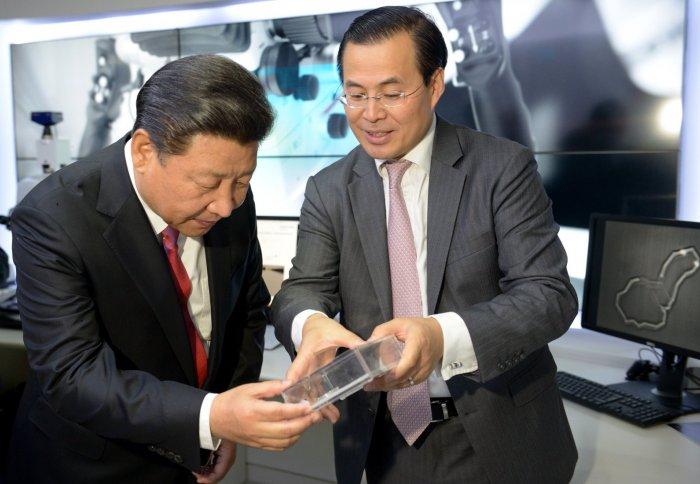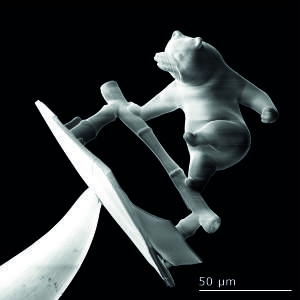The Great Wall of China is estimated to be over 13,000 miles long, and, at its tallest, is about 26 feet high. It’s hard to believe that something so massive could be shrunk down to the size of a human hair, isn’t it? Well, in fairness, the actual wall has not been shrunk. But thanks to a Nanoscribe 3D printer, Chinese President Xi Jinping is now in possession of a microscopic replica of a portion of the famous Wall.
On October 21, President Xi and the Duke of York, Prince Andrew, along with several other Chinese and English dignitaries, visited Imperial College London. Over the last decade, the College has developed several collaborations with major Chinese research organizations, and President Xi’s visit coincided with a number of announcements regarding future educational and research partnerships between Imperial College and Chinese institutions. During the visit, President Xi and the Duke of York stopped by the College’s Hamlyn Centre, which has been at the forefront of research into healthcare technology.
The Hamlyn Centre has been using a Photonic Professional GT 3D printer from Nanoscribe to develop some groundbreaking medical procedures, including swimming microbots for targeted drug delivery and miniscule surgical tools that could be used for delicate micro-surgeries like eye operations.
The printer utilizes a technique known as Two Photon Polymerization, in which a controlled laser point is used to solidify a liquid, photo-sensitive material. The process allows for incredibly precise objects to be 3D printed at a scale as small as 150 nanometers, which is approximately the size of the grooves on CDs. To demonstrate the technology to their visitors, the Hamlyn Centre presented President Xi and the Duke of York with microscopic gifts.
“A section of the Great Wall of China was printed on to a square of silicon at one millionth of its true scale,” said PhD student Maura Power. “The section of wall is just over 100 micrometres long, which is the same as the width of a typical human hair. An image of the printed wall was acquired using a Scanning Electron Microscope. The length of the letters in this image are approximately the same diameter as that of human red blood cells. This microscope picture was mounted next to the silicon wafer in a frame which was wrapped in red ribbon and presented to President Xi by Professor Guang-Zhong Yang. “
The Duke of York was presented with what is, most likely, the tiniest panda ever. According to Power, the panda, which is depicted leaping over a bamboo branch, was printed at the size of the tip of a needle. The panda’s height is 50 micrometers, which is approximately half the width of a human hair.
The Hamlyn Centre’s research is being funded by the Engineering and Physical Sciences Research Council (EPSRC), which is based in Swindon, England and has a research facility based at the Hamlyn Centre. The on-campus microengineering facility is dedicated to the research of micro-robotics for minimally invasive surgical procedures.
It’s hard to imagine that the most advanced, complex medical technology could be invisible to the naked eye–though we’ve seen other 3D printed sculptures just as small, some lost forever and some intended to get a message across, from artist Jonty Hurwitz. Discuss this story in the 3D Printed Great Wall of China forum thread on 3DPB.com. You can also watch the tiny Great Wall being printed here:
Subscribe to Our Email Newsletter
Stay up-to-date on all the latest news from the 3D printing industry and receive information and offers from third party vendors.
You May Also Like
3D Printing Unpeeled: New Arkema Material for HP, Saddle and Macro MEMS
A new Arkema material for MJF is said to reduce costs per part by up to 25% and have an 85% reusability ratio. HP 3D HR PA 12 S has been...
3D Printing News Briefs, January 20, 2024: FDM, LPBF, Underwater 3D Printer, Racing, & More
We’re starting off with a process certification in today’s 3D Printing News Briefs, and then moving on to research about solute trapping, laser powder bed fusion, and then moving on...
3D Printing Webinar and Event Roundup: December 3, 2023
We’ve got plenty of events and webinars coming up for you this week! Quickparts is having a Manufacturing Roadshow, America Makes is holding a Member Town Hall, Stratafest makes two...
Formnext 2023 Day Three: Slam Dunk
I’m high—high on trade show. I’ve met numerous new faces and reconnected with old friends, creating an absolutely wonderful atmosphere. The excitement is palpable over several emerging developments. The high...


































